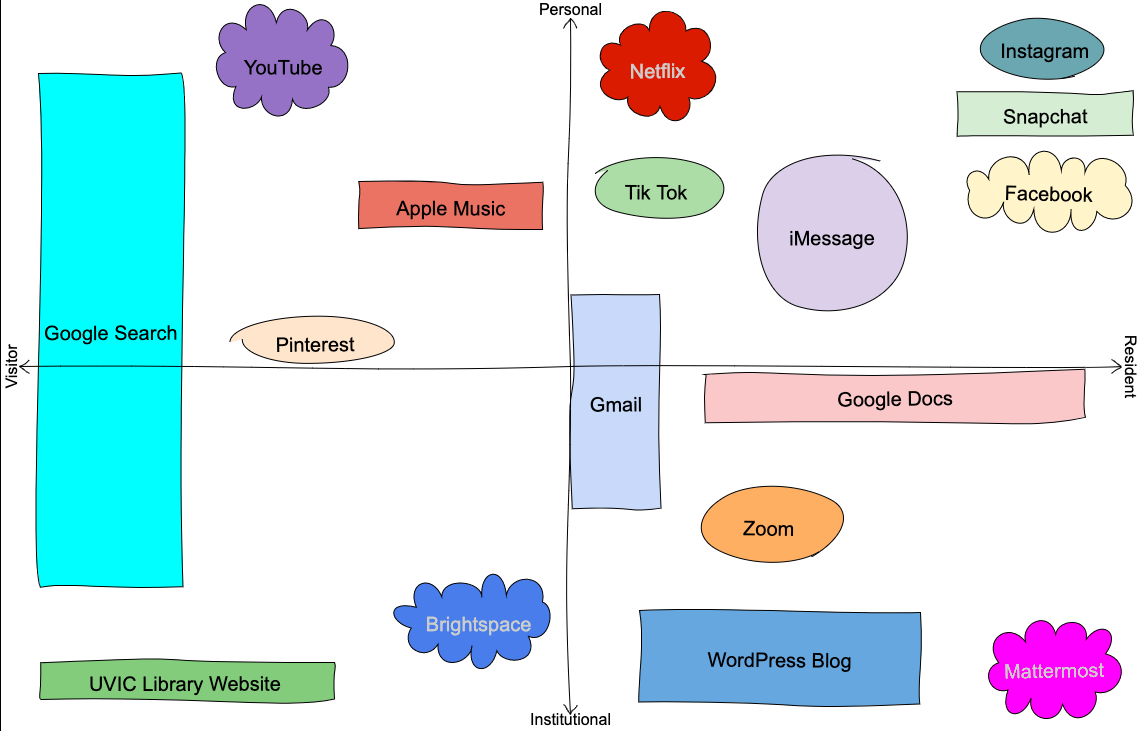I really enjoyed creating the visitor and resident map! I found the brainstorming process interesting, as it encouraged me to consider how I engage with different social media platforms and how these platforms contribute to my digital identity. While creating my map, I focused on whether the platforms are used for personal or professional use. Furthermore, I consider whether I used the apps for a specific goal, meaning I am a visitor, or I used the platform to connect with others online, which would mean I am a resident (“Digital Visitor and Resident”). After creating my map with these components in mind, I noticed that a majority of platforms fall under the resident side, as I tend to use the internet to connect with others. If apps/ websites are on the resident side of the map, traces of yourself are left behind (“Using the Digital Visitors and Residents App,” 0:52-1:00). This means that these apps contribute to my digital identity and help create my footprint on the web (Stoller, 0:04-0:37). After completing the privacy awareness quiz, I discovered that I need to be a little more aware of what I share online to protect my privacy. For example, I never really thought of public WIFI networks having an impact on my online privacy (“Privacy and Surveillance Quiz”). This is important especially because the platforms I use favour the resident side of the V&R map. The quiz informed me it is critical to be aware of privacy concerns and as I move forward with social media use, I need to be a little more aware of it.
As a student, the main platform I use to contribute to a positive digital identity is my WordPress Blog. This year, I have created a couple of blogs that have information about me, my teaching philosophies, and assignments from a variety of classes. My WordPress blog has been shared with my peers and members of the UVIC Faculty of Education. The work I share on my blogs contributes to a professional digital identity and has been a great starting point to developing my professional PLN. However, I think that I can work on expanding my professional network through engaging in social media platforms with a professional approach. To grow my PLN, referring to online resources and developing connections with other educators can help me with my growth goals. As I transition into teaching, I think it would be beneficial to create professional social media accounts. This will allow me to easily connect with other educators and gain inspiration.
For EDCI 336, one of my peers and I created a presentation on how Instagram can be beneficial to teachers. A major outcome after creating this resource is that Instagram, along with other social media platforms, can be a useful source to connect with others professionally, gain inspiration, or document/ share work. Thus, making it a goal to create professional social media accounts can be beneficial to my career.
Here is a link to our presentation for more information about teachers and Instagram: https://docs.google.com/presentation/d/1DMwqya7Sr1pGWF5h2WWc_ptx_1i25eMCF7MkybUCnFI/edit?usp=sharing
If an employer searched my name, I do not think they would find anything that would hinder the opportunity. However, I do not think there would be anything that would be specifically beneficial as well. As I mentioned above, my WordPress blog would be the most influential thing toward my digital identity. However, as for my social media accounts, there is not anything that would show as a benefit to future employers. To prepare for the future, I could work on creating professional Twitter and Instagram accounts where I can connect with others and work on forming professional digital identity. When using social media platforms professionally, it is important to keep my digital identity at the focus, which means placing attention on privacy concerns (“Privacy and Surveillance Quiz”). By doing this, I can focus on growing my PLN and creating a professional stance on social media.
Works Cited:
“Digital Visitor and Resident.” Wikipedia, Wikimedia Foundation, 6 May 2021, https://en.wikipedia.org/wiki/Digital_Visitor_and_Resident
“Privacy and Surveillance Quiz.” The University of British Columbia, https://digitaltattoo.ubc.ca/quizzes/privacy-and-surveillance/. Accessed 25 May 2021.
Stoller, Eric. “What is Digital Identity?” YouTube, uploaded by University of Derby, 25 November 2016, https://www.youtube.com/watch?v=u0RryRbJza0.
“Using the Digital Visitors and Residents App.” YouTube, uploaded by OCLC Video, 5 May 2016, https://www.youtube.com/watch?v=6ai0ZO3lDR4&t=2s



maracox
May 29, 2021 — 3:36 pm
Hi Olivia,
Great post this week. You mentioned the use of public wifi networks and privacy – I had similar thoughts after doing the quiz too! I don’t find myself using public wifi too much when I am in Canada, but it has often been my primary internet source when I am out of the country! I will definitely be more aware of my public network use from now on. I have found that VPNs can be a fairly easy way to feel a bit more protected on these networks.
I love your idea about creating professional ‘teacher’ social media accounts! That has been something that I’ve thought about a lot this year as I finished my final practicums and moved into the role of a certified teacher, although I am definitely still more of a content consumer than a content creator! Maybe one day.
Thanks for the great read!
aeshaa
May 29, 2021 — 10:04 pm
Hi Olivia,
I enjoyed reading your post this week! I also am now more cautious about what public WiFi networks expose my information to. WordPress is a great tool to expand your PLN and have a professional presence online as well In the V&R map, we both use Instagram and Gmail similarly. It’s very interesting to see how we use social platforms for professional life, entertainment, networking or all at once!